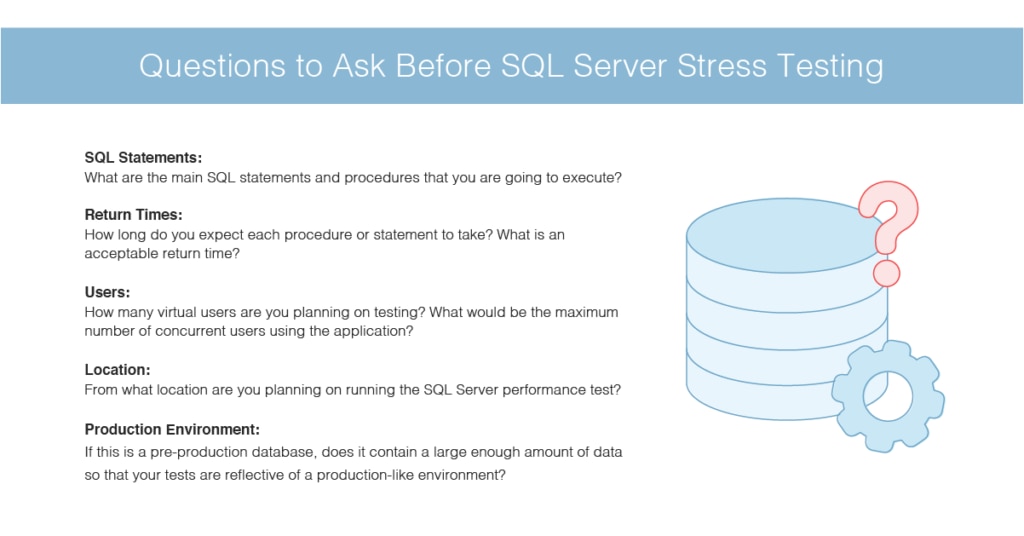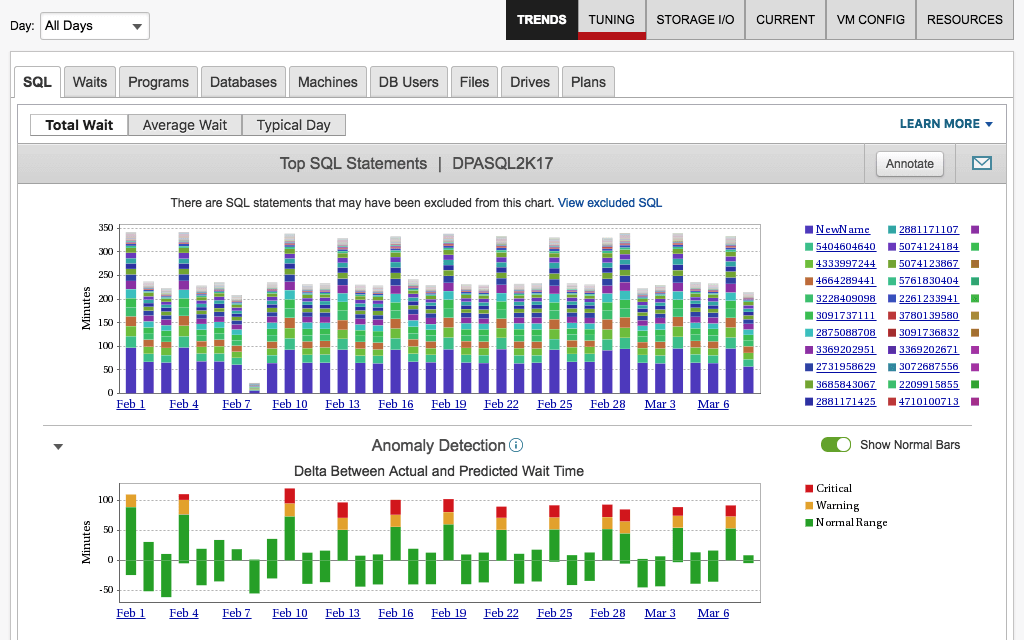SQL Server performance testing is an invaluable practice and can yield notable benefits. SQL Server performance tests can be used for a range of purposes, included but not limited to performance tuning, capacity planning, and identifying bottlenecks.
This article will outline the importance of SQL performance testing, what you need to get started with stress testing, and how using the appropriate SQL performance tools can make your approach to stress testing more efficient. The aim of this article is to help you understand the variables required for a SQL Server performance test and what questions need to be answered to ensure the stress test environment you create is both productive and successful. If you are looking for reliable, user-friendly, and enterprise-grade SQL performance tools, then SolarWinds® Database Performance Analyzer (DPA) comes highly recommended.
What Is a SQL Performance Test?
Questions to Ask Before a SQL Server Performance Test
What Makes a Good SQL Server Stress Test?
Important Performance Counters
Choosing the Right SQL Performance Testing Tools
What Is a SQL Performance Test?
Stress testing, sometimes referred to as load testing, involves running many statements/transactions from various connections or threads against a SQL Server database. The aim is to discern how well the database server copes with a high-stress or high-load environment.

Questions to Ask Before a SQL Server Performance Test
Before running a SQL performance test, you should ask yourself the following questions:
- What main SQL statements and procedures are you going to execute during the test? If you’re testing procedures called by an application, then hopefully answering this question shouldn’t be much of a challenge. Certain SQL performance testing tools record the SQL statements being executed by users while the web or software front end is in use.
- How long do you expect each procedure or statement to take to be executed to completion? What do you consider to be an acceptable return time?
- How many virtual users are you planning on testing? If this will be the back end of a software or web application, then what do you consider to be the maximum number of concurrent users using the application?
- From what location are you planning on running the SQL Server performance test? If you’re monitoring from across the network, remember you’ll incur some DCOM hit. If you’re monitoring locally on the server, on the other hand, it may consume marginal resources.
- If this is a pre-production database, does it contain enough data to ensure your tests reflect a production-like environment?
What Makes a Good Stress Test?
A good stress test involves more than sending an onslaught of statements to your SQL Server. A stress test is rendered practically obsolete if it’s not measurable. When you stress test your SQL Server, you must have some way of gathering performance-related statistics and data. We recommend gathering performance counters and, if possible, the actual execution times for the statements. You can gather performance counter statistics by using Microsoft Performance monitor, or alternative third-party tools like SolarWinds DPA .
To successfully measure the results of a stress test, you must first establish a baseline for comparison. An appropriate baseline might be based on past performance figures or thresholds your team considers to be acceptable. Baselines are often previously saved results against which you can compare the new stress test results. You may also want to compare your test results against thresholds listed by industry professionals or by Microsoft. When you first run a test, simply save your results and they’ll serve as a baseline for future tests. You should create baselines periodically, for ongoing comparison purposes. Baselines are an excellent way of trending and predicting growth rates.
Important Performance Counters
When choosing your performance counters, the aim is to discern not just how the SQL Server is performing, but also how the hardware and network is performing. Here are the most important performance counters for SQL performance testing.
- Network Interface: Bytes Total/Sec
- Physical Disk: % Disk time
- Physical Disk: Avg. Disk Queue Length
- SQL Server Buffer: Buffer Cache Hit Ratio
- SQL Server General: User Connections
- Memory: Pages/sec
- Memory: Available Bytes
- Processor: % Processor Time
- System: Processor Queue Length
Choosing the Right SQL Performance Testing Tools
SolarWinds® Database Performance Analyzer (DPA)
SolarWinds Database Performance Analyzer is a market-leading SQL Server performance testing solution with a user-friendly, dynamic, and advanced approach to stress testing.
One of DPA’s best features is its response time analytics capabilities. DPA’s SQL performance analyzer is designed to correlate activity, SQL statements, wait types, and other dimensions to help pinpoint the root cause of database slowdowns. This tool gives you detailed insight into your MSSQL database, including wait times, queries, plans, changes, resources, and historical analysis.

SolarWinds DPA also assists you with optimizing all your production databases. DPA’s agentless architecture is safe to use in development, test, and production environments. It also supports virtualized or cloud-based environments, with support for Amazon AWS, EC2, RDS, and Axure. DPA features a SQL Query Analyzer utility, which monitors development, test, and production servers with less than a 1% load, allowing you to commence query optimization in SQL Server prior to deployment. This tool also allows you to safely monitor SQL code performance in production.
DPA helps businesses align developers, operations, and DBAs. With its simple, web-based interface, DPA lets teams collaborate and helps ensure they’re on the same page regarding how new code might impact performance. This tool allows you to achieve maximum performance without needing to extend resource or hardware capacity, wherever possible, by giving you insight into the cause of a performance bottleneck. By helping you pinpoint the root cause of an issue, DPA enables you to validate your hardware purchases.
One of the reasons DPA is so easy to use is because it presents all information and key performance indicators in the form of bar charts and associated alerts. This gives you easy access to important data, enabling DBAs and application teams to reduce downtime, effectively optimize resources, and rapidly identify which SQL queries require their focus.
SolarWinds® SQL Sentry
Another solution, SolarWinds SQL Sentry, can also help you tackle performance issues in a SQL clusters by providing deeper insights into performance over time to help you identify when the issue occurred, so you can start and gain actionable insights from performance testing and troubleshoot problems immediately.
SQL Sentry also provides the ability to:
- Go back in time or a specific time range to see changes that occurred in SQL Server
- Set individual baselines and more easily compare performance metrics
- Grant read-only access to users, allowing support teams the ability to review dashboards as well
Download a free 14-day trial to try out SQL Sentry for yourself.
How to Start SQL Performance Testing
While there are lots of components to consider for SQL Server performance testing, the right SQL performance tool can help you streamline the process and boost productivity. SolarWinds DPA enables you to hit the ground running when it comes to stress testing and is an ideal tool for businesses looking for a combination of user-friendliness, scalability, and sophisticated capabilities. DPA is a firm favorite among SQL database professionals and developers. You can get started with DPA with no previous experience or training. A 14-day free trial is available for download.


